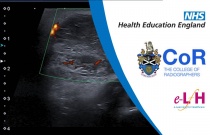Image Interpretation - Musculoskeletal Ultrasound: Shoulder
Sara Riley
0.50 Hours
This session considers the sonographic appearance of the shoulder. It will include an overview of normal appearances and common pathology, and discuss common pitfalls to avoid. Tips on reporting will be offered.
Image Interpretation - Musculoskeletal Ultrasound: Ankle and Foot
Warren Foster and Stephen Duffy
0.50 Hours
This session will describe the anatomy and scanning technique used in ankle and foot assessment. Common pathology and pitfalls are discussed. Tips on reporting will be offered.
Introduction to Patient Safety in Primary Care
Jane Carthey and Christine Johnson
0.50 Hours
This session will provide an overview of key patient safety issues and challenges in primary care. It will also explain why improving patient safety requires us to look at the healthcare system, not just to focus on an individual healthcare provider.
Introduction to Immunisation
David Elliman and Helen Bedford
0.50 Hours
This session describes the knowledge and competencies required of healthcare professionals to advise on and deliver immunisation programmes.
Introducing and Using a Developmental Journal
John Oates
0.50 Hours
This session gives details of the range of Developmental Journals for children and young people of different ages and with different developmental support needs. It also covers how the journals can be used in practice.
Doppler in Intensive Care Echocardiography (DICE): Theory
Dave Woodward
0.50 Hours
This session develops basic 2D transthoracic echocardiography practice by describing Doppler theory and its clinical applications. It explains the role of Doppler in the comprehensive evaluation of cardiac function, valve pathology, and basic haemodynamics.
Doppler in Intensive Care Echocardiography (DICE): Clinical
Dave Woodward
0.50 Hours
Doppler imaging is essential for comprehensive assessment of cardiac function. Basic Doppler techniques can enhance the value of echo examination particularly when valve pathology is present.
Full-field Electroretinography Part 2
Anthony G. Robson and Antonio Calcagni
0.50 Hours
This session details how to interpret the normal and abnormal full-field electroretinogram (ERG). It also describes the main indications for performing an ERG with some illustrative examples.
Liberating Learning - Patient Based Strategy
Sameer Trikha and Bijan Beigi
0.50 Hours
This session details how to perform capsulorrhexis, hydrodissection and hydrodelineation.
Image Interpretation – GI and GU Imaging: Imaging of the Bladder
Jane Belfield
0.50 Hours
This session gives an overview of bladder imaging, including different imaging modalities that can be used to identify normal bladder anatomy and common pathologies.
Image Interpretation - Neurointervention: Treatment of Neurovascular Pathology
Lisa Flett
0.50 Hours
This session explores the treatment of neurovascular pathologies including the devices commonly used in their treatment.
Image Interpretation - CT Anatomy: Cervical Spine
Paul Simpson
0.50 Hours
This session will look at the anatomy of the cervical spine on computed tomography (CT) images. It will cover both bony structures on a series of axial, sagittal and coronal images.
Endometrial Neoplasia
Sophie Forsyth , Sarah Cochrane and Amy Keightley
0.50 Hours
This session will cover the aetiology, epidemiology and pathology of endometrial cancer, and also describe clinical presentation and management of this disease.
Image Interpretation - Head and Neck Ultrasound: Lumps and Bumps
Catherine Kirkpatrick
0.50 Hours
This session describes the normal anatomy of the neck and then details how neck lumps are assessed and diagnosed.
Image Interpretation - Adult Skeleton (X-ray): Self-evaluation - The Axial and Appendicular Skeleton
Dorothy Keane
0.50 Hours
A self-evaluation session designed to support you in assessing your image interpretation skills and report writing style. All radiographs in this session relate to the appendicular and axial skeletons.
Image Interpretation - Plain X-rays of the Adult Chest: Hila, Mediastinum and Heart
Andrew Yeung and John Tuckett
0.50 Hours
This session will focus on the hilar regions and also the mediastinal structures including the heart. The anatomy and common pathology of these areas will be discussed and related to their appearances as seen on chest radiographs.
Image Interpretation of the Paediatric Skeleton: Suspected Physical Abuse - Case Study 2
Claire Giles
0.50 Hours
This self-evaluation session presents a case study for review regarding paediatric suspected physical abuse.
Image Interpretation of the Paediatric Skeleton: Suspected Physical Abuse - Case Study 4
Claire Giles
0.50 Hours
This self-evaluation session presents a case study for review regarding paediatric suspected physical abuse.
Image Interpretation of the Paediatric Skeleton: Suspected Physical Abuse - Case Study 7
Claire Giles
0.50 Hours
This self-evaluation session presents a case study for review regarding paediatric suspected physical abuse.
General Radiation Protection - Radiology
Elizabeth Davies
0.50 Hours
The aim of this session is to provide a short introduction to the main methods of dose reduction used in radiation protection.
Image Interpretation - Magnetic Resonance Imaging: Foot and Ankle - Session 1
Dorothy Keane
0.50 Hours
This session will look at the anatomy of the foot and ankle using both diagrams and magnetic resonance (MR) images. It will then describe a range of mechanisms of injury affecting the bones and soft tissues. Techniques for magnetic resonance imaging (MRI) of the foot and ankle will be discussed.
Image Interpretation - Magnetic Resonance Imaging: Foot and Ankle - Session 2
Dorothy Keane
0.50 Hours
This session will look at common pathologies found in the foot and ankle which can be identified on magnetic resonance imaging (MRI). Pathology will be illustrated using MRI examples.
Hindfoot Pain: Enthesopathy - Radiology
Philip O'Connor
0.50 Hours
This session deals with the most common causes of heel pain and their imaging findings.
Mass Posterior Knee - Radiology
Zachary Jafri and Martin Watson
0.75 Hours
This session is designed to help you accurately interpret the imaging appearances of a popliteal fossa mass. Other, less common masses are also explored.
Image Interpretation of the Paediatric Skeleton: Child Development - Relevance to Imaging Children
Alison Tonkin and Claire Weldon
0.50 Hours
This session will describe and explore how children develop from birth to the end of adolescence and how this impacts on considerations for communication before, during and after their diagnostic imaging procedures.
























